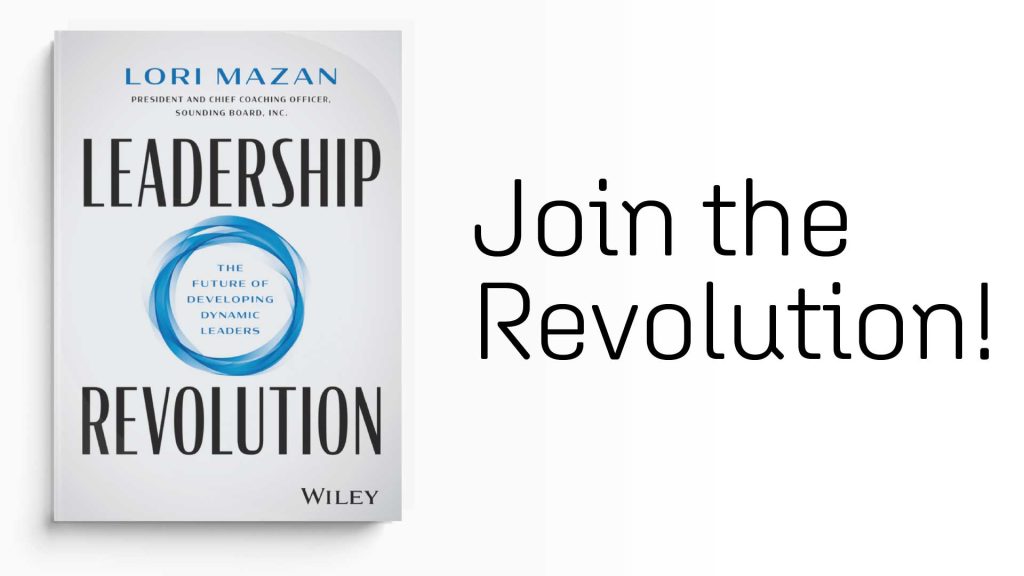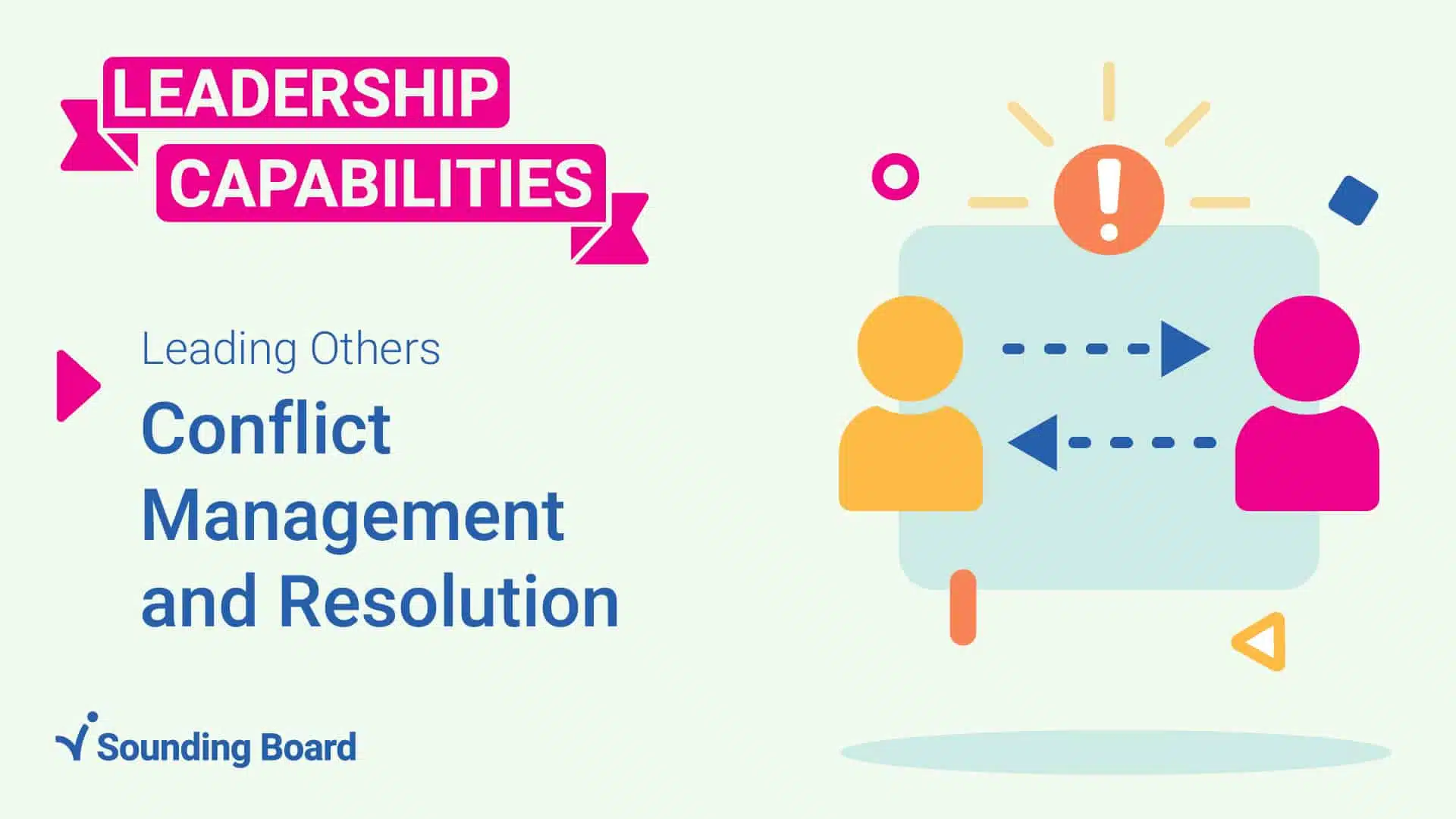This blog is part of a 16-part series focused on what capabilities make a strong leader. Sounding Board has identified 16 leadership capabilities that the strongest leaders possess. These were developed from research-backed leadership theories, leadership competencies used for evaluation from top business schools, and 25+ years of practical coaching application.
When you lead different kinds of projects, people, and personalities, you are bound to come across instances where your team looks to you for guidance in moments of uncertainty or conflict. Workplace conflict is a natural and unavoidable facet of people leadership.
But conflict doesn’t have to be scary or tumultuous. With effective leadership skills, you can not only manage your people and their conflicts, you can arrive at resolutions that make all parties feel heard and valued.
Conflict management and resolution-making skills are core leadership capabilities for people leaders. What follows is a guide to manage workplace conflicts, and we will explore some key skills that drive impact and successful resolutions.
Why is conflict management a leadership imperative?
It’s important to understand the relationship between your role as a leader and conflict management. Essentially, why should you prioritize developing this leadership capability? Managing conflict while remaining solutions-driven is a key skill that speaks to a leader’s ability to consistently maintain high productivity and morale in the workplace.
There are two common types of conflict that often arise at work:
- Conflict between individual members of the team; or
- Conflicts regarding your team’s established goals.
As a leader, your people look to you for clarity around roles and responsibilities, as well as understanding. So, when things are unclear and conflict bubbles up, it’s imperative that leaders are there to set the tone and provide clarity again — whether that means redistributing tasks, listening to and addressing interpersonal issues, or anything in between.
The ability to recognize conflicts on your team and resolve them quickly is essential, not only for continued productivity and success, but also for its psychosocial impact on your people. It’s no secret that happier workers produce greater results. So, while conflict can’t be avoided completely and you can’t make everyone happy, as a leader you can take steps to turn these moments into productive opportunities for learning and growth.
A guide to managing conflict
Mastering conflict resolution skills can take time and a significant amount of energy. But with enough practice and by keeping a few simple guidelines in mind, effective conflict management can transform the way you build and lead great teams. Here are a few foundational steps to start with:
- Listen: Your first role as a leader is to actively listen to your people with an open mind. Get all sides of the story, and diagnose the conflict. Is it between people and personalities, or does it have something to do with systems or project management? Fully assess the situation before you decide how to intervene.
- Identify patterns or triggers: As you lead, over time you may notice patterns or particular triggers for conflicts among your team members. A good leader has insight into these forces and not only addresses the conflict at hand, but takes steps to treat the root cause as well. For example, if there is a team process that repeatedly causes problems, reexamine it to see if things can be done differently so that a similar conflict doesn’t arise again.
- Set boundaries: In the process of managing conflict, you might notice unproductive behaviors come up. For instance, maybe some team members are engaging disrespectfully with one another. As a leader, it’s vital that you establish and hold yourself and your people to healthy boundaries so that minor conflicts don’t get out of hand and cause lasting wounds. Defining acceptable behaviors and holding everyone accountable to those standards is one way to ensure that.
- Talk it out: Once you’ve assessed the situation and established healthy boundaries, it’s time to talk things out. This is the time to put your communication and facilitation skills to good use. Popular American author, speaker, and researcher Brene Brown calls this step the rumble: “a discussion, conversation, or meeting defined by a commitment to lean into vulnerability, to stay curious and generous, to stick with the messy middle of problem identification and solving.”
- Establish goals moving forward: Now that you’ve successfully addressed the conflict at hand, it’s important to take some prescriptive or corrective action before the next conflict occurs. A good resolution outlines new boundaries and expectations from which to move forward. This should be a collaborative effort that includes your team members’ voices, and subsequently calls for their accountability as they move onward.
Essential skills that drive impact and resolution
There are a few essential leadership capabilities that come in handy even as you follow the aforementioned steps. They entail many of the intangible, more elusive but no less critical competencies that can make or break leaders as they ascend the career ladder. These competencies are almost always present in the world’s top leaders.
When it comes to successfully managing conflict and resolutions, these competencies include:
- Effective communication: Provide your people with clarity and honesty.
- Active listening: Actively engage with your team members; ensure they feel heard.
- Practicing empathy: Put yourself in others’ shoes for a moment; make an effort to understand your people.
- Establishing neutrality: Every conflict has multiple perspectives. Listen to all without favoring any.
- Being level-headed: Don’t let emotions get the better of you or your team members.
Keeping these things in mind can have a significant impact on the way you lead your team through rocky moments and prevent future conflicts from arising. Undoubtedly, your team will be better for it.
Putting it all together
At Sounding Board, our expert, certified coaches know that conflict is an inevitable part of the work world. No matter how great the leader, conflict can impact even the most talented peace-maker. But it doesn’t have to leave a lingering sense of negativity in its wake.
We offer high quality leadership coaching services designed to equip you with the tools needed to navigate tumultuous moments, and carry your people forward with confidence. Effective leadership coaching can help you learn how to consistently adopt a solution-driven approach to creating resolutions. To learn more about our leadership coaching services and our award-winning Leader Development Platform, request a demo today.











